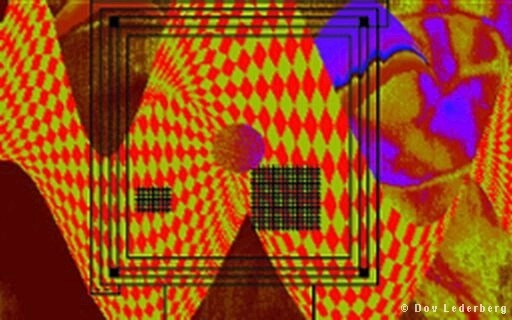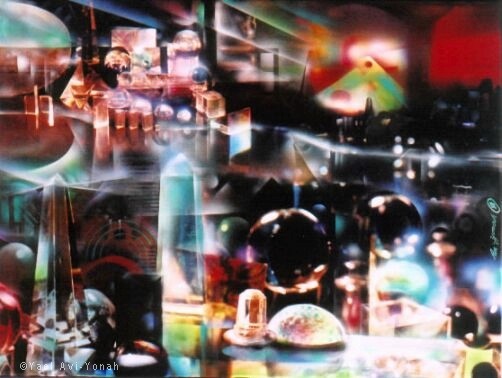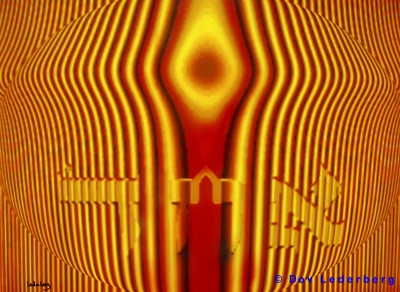Transcendent
Visions

October
30-November 14, 2007
Touro
College New York
227
West 60th Street
New York, NY 10023
Review
by Dr. Maya Balakirsky-Katz
Professor
of Art History
Touro
College
Touro
College is pleased to host Transcendent Visions,
an
exhibition featuring the works of Jerusalem artists
Yael Avi-Yonah
and
Dov Lederberg.
"The
true talent of a visual artist, when he is at the peak of his
abilities and especially one whose talent has been
sanctified by the
Spirit of G-d is to be able to see the
depths of existence, both in
their physical and spiritual
dimensions."
Rav
Kook, Ein
Ayah,
Berachot, volume 2
In
their exhibit Transcendent Vision, Jerusalem artists
Yael
Avi-Yonah and Dov Lederberg challenge us
to acknowledge that what we
see is suspect,
open for interrogation,
and malleable in the hands of
the artist.
In this sense, they join in the tradition of
some of
the great critics
of the Renaissance masters,
who were both cynically
aware and spiritually
affected by the art of illusion.
This
generation of artist-critics didn't trust
the laws of
two-dimensional perspective,
which seemed to "trick" the visual
system into
accepting a three-dimensional space on a flat canvas.
On
the other hand, they developed
their own set of visual manipulations
to attract not only the eye, but the heart as well.
In the art of
the post-Renaissance artists
El Greco, William Hogarth,
Diego
Velazquez,
and Andrea Pozzo,
visual perception becomes the very subject of
inquiry,
susceptible as it is to
the
vicissitudes
of the viewer's psychological disposition.
The
history of modern art has been preoccupied
with the divide between
belief in accurate representation
and the agonizing confrontation
with its limitations.
Modernism has been preoccupied with the
spiritual,
which scholars have juxtaposed to the material.
Avi-Yonah
and Lederberg take a hard "look"
at these seemingly polarized
categories.
Twentieth-century
modernists,
such as Wassily Kandinsky, Kazimir Malevich,
Piet
Mondrian,
and American artists Barnett Newman,
Marc Rothko, and Ben
Shahn
saw themselves as divorced
from the mundane skill of copying
the natural world,
and found inspiration in Kabbalistic themes.
The
illusionist art of Avi-Yonah and Lederberg
enters this dialogue with
a series of works
that challenges and mesmerizes our perceptual
system,
as they confront the Jewish spiritual experience.
We
approach their illusionist works
with wonder and delight.
Both
artists tend to work in series
motivated by theme rather than
narrative.
Since the 1970s, Avi-Yonah has been working
on a series
of paintings in a style
which she calls Anaglyphic Art.
Avi-Yonah's themes include
the Four Angels, the Four Worlds,
Jerusalem in the
Messianic Age,
Mysteries of the Black Hole and Hologramic
Energies.

Lederberg's themes include the exploration
of the Hebrew scribal tradition in his
Sacred Letters series
the texture of the rock surfaces of the Wailing
Wall,
and Kabbalah Dialogues.
What
we think we see and what we see on second glance
and what we see through anaglyphic red-and-green
lenses,
changes with every viewing.
The image transforms when we
rotate the canvas on its central axis,
and when the video
screen morphs the letters of the Hebrew alphabet.
The insistence on
interactive viewing
produces an unstable, evolving form of vision.
We
are so accustomed to judging an image
on the relationship it bears to
the natural world,
that we are not sure how to confront a conceptual
image of an object
that does not occupy the physical universe.
Avi-Yonah's image of Gabriel, associated in Kabbalistic sources
with the Face of the Bull in Ezekiel's
vision of the Divine Chariot
(Mirkavah),
defies traditional Western images of angels (Ezekiel 1:10).
We
approach Avi-Yonah's
portrait
of
the Angel
with suspicion, if not downright trepidation.
The
Angel stands at the entrance of the exhibit,
a directional sign
beckoning the viewer
to enter a space of animated letters, the future
city,
visions of the Holy Temple, and the Garden of Eden.
The
painting's triangular format and subject are foreign,
yet vaguely
familiar with its use of
simple geometric shapes and iconic symbols.
The image draws upon our literary banks,
and yet evokes something
foreboding and strange.
The colors are reminiscent of violence and
sacrifice,
but the texture is evocative
of meticulous and luxurious
handicraft.
The juxtaposition between the aggressive color
and the
tender texture is jaunting.
In the Book
of Daniel,
Gabriel serves as
the interpreter of incomprehensible images.
The
prophet Daniel narrates his own confrontation
with mystifying images:
"While I, Daniel, was seeing the vision,
and trying to understand
it,
there appeared before me one who looked like a man.
I heard a
human voice
from the middle of the Ulai River
calling out, Gabriel, make that man
understand the vision.
He
came near to where I was standing,
and as he came I was terrified,
and fell prostrate.
He said to me,
Understand O man, that the
vision
refers to the
end of days.
(Daniel 8:14-18)
Gabriel
hardly orients his terrified viewer
to an accessible, familiar space
to observe his vision,
but he does give him permission to anticipate
a reality based on the seemingly incomprehensible vision.
Gabriel
instructs
that the future will reflect the image,
rather than the image
reflecting the present natural world.
Unlike the Renaissance masters
who held up a work of art to nature,
our viewer must await a reality
that will one day conform to his vision.
Avi-Yonah's
Gabriel
conveys a prophetic world in its use
of the symbols of the
fiery Bull of the Chariot
and
the shofar,
but startles in its use of
the silky quilt-like texture and bloody
background scheme.
The perverse harmony of the work
with its
recurring motifs and symmetrical layout
insists on a visual order
that we do not intrinsically feel.
If this angel is to be our guide
to the work of Avi-Yonah and Lederberg,
then indeed these are images
that refer to the end of days.
The challenge for Lederberg and
Avi-Yonah
is how to express in material form
that which is spiritual:
messianic yearning,
a relationship to one's Creator,
and the breadth of human dialogue.
The works of Avi-Yonah and Lederberg
open our eyes to an intangible
world of the future.
As
their works move towards envisioning
the Jerusalem described by the
prophets,
Avi-Yonah and Lederberg face
the challenge of
conceptualizing a Messianic Jerusalem
in a Jerusalem that is no
longer in ruins.
Their home in
the neighborhood of Shaarei
Chesed
was designed almost
a hundred years ago
during the Ottoman Empire
by Jewish philanthropists hoping to
reestablish
Jewish life and culture outside
the Old City
of Jerusalem.
Today, their home serves as its own artists' colony,
with Yael working in her studio upstairs
and her
husband
Dov working in his space
downstairs.
Avi-Yonah
was born in Jerusalem
and is a
graduate of Bezalel Academy of Art,
an institution that envisioned
art
as integral to the rebuilding of a Jewish state.
From its
founding in 1906 by Boris Schatz,
Bezalel workshops stressed
a
living, thriving, and contemporary Jewish artistic tradition
in the
effort to establish Jewish life and culture
in Eretz
Yisrael.
For this reason, the Bezalel School
was as much about the means of
production
as about the final product,
a concept that both Avi-Yonah
and Lederberg
have taken to heart.
For
Lederberg, process is the art,
and the canvas is the product of the
creative act.
Lederberg's
Dialogues
series, for example,
include a work entitled Birthing.
The
image however is not the birth of the body,
but of "becoming".
The primal matter that is actively evolving
never
forms into a material product.
The individual works within the
series of Dialogues
is, therefore,
not a visual object as much as the process of
creation.
Lederberg never describes a work as "finished"
but as
a version or edition of a new technique.
On the cover of
Schatz's Utopian work,
Yerushalayim
ha-Benuya (Jerusalem Rebuilt),
Schatz receives instruction on the roof of the Bezalel building
from
the Biblical architect
of the mishkan
and the menorah,
Bezalel ben Uri.
In his artist's manifesto, Lederberg writes,
"I
regard myself as a Jewish visionary artist,
continuing in the
tradition
of the Biblical artisan, Bezalel,
whose name means "in
the shadow of G-d,"
which implies being essentially
a "receiver"
of spiritual vision.
In
Yerushalayim
ha-Benuya,
Schatz
writes
of the redemptive process of artistic creation
and goes on to
claim that his museum of Jewish art
will become part of the Third
Temple.
A century later, the artists live in a thriving, urban city
where the ancient city confronts the demands of modern life.
It is
no wonder, then, that Lederberg
in his Visions
of the Holy Temple
objectifies
the narrative elements from our ancient sources
with
abstract
illusionist art
created mainly with the contemporary technique
of the
air-brush, a modern technique popular
with science fiction and
fantasy illustrators.
From his experience in experimental
film-making
in the Sixties as an active member
of the
New
American Underground
and the N.Y. Filmmakers' Co-op,
Lederberg synchronizes
a basic architectural template of the Holy of
Holies
to the mounting waves of repetitive reds and yellows
reminiscent
of musical composition.
In
creating a sensation that emanates from
the central architectural
figure in the center,
Lederberg maximizes aural,
rather than the
visual effects of the Temple
and the future Temple service performed
to the majestic music of the Levites.
Although
Lederberg's treatment
of architectural forms
calls upon our
auditory senses
in what might appear a break with tradition,
he draws
from the Chasidic
transformation
of the visual prayer experience
to the experience of
aural prayer and meditation.
In
reviewing the work of post-Impressionists
Cezanne, Van Gogh, and
Gauguin,
critic Maximilian Voloshin claimed
that one heard art before
one saw art.
The Russian artist Wassily
Kandinsky
tried to paint music,
specifically the compositions of
Arnold Schoenberg,
an experiment that resulted
in the creation of
pure abstraction in art.
But if music has a face,
then the service
in Lederberg's Temple
would hardly sing a chasidic niggun
or an upbeat klezmer
ditty from the shtetl.
The songs in his Temple compositions
are techno, modern,
and mesmerizing.
Avi-Yonah's
Holy
City
transforms
her native city of Jerusalem stone
to a majestic
world
of precious gemstones.
Using her anaglyphic technique, Avi-Yonah
combines two different
images of the future city,
while preserving a thematic unity.
Her
vision innovates in so much
as it describes the end of days
but it is also vaguely familiar in the sense
that it creates a
skyline with both
skyscrapers and low buildings,
city blocks and
intersections,
and the urban beauty of maximized space.
The
compositional angle Avi-Yonah
chose for her vision of the future city
is the burial ground of the
Mount of Olives (Har
HaZetim),
where
Lederberg's parents
and great, great grandparents are buried.
She divides the canvas
with the flowing waters of the four rivers
that cover the Valley of Kidron
in the apocalyptic vision of the Book
of Zechariah.
Avi-Yonah
comes from a long tradition
of exploring and envisioning the city of
Jerusalem.
Her
father was the distinguished archaeologist
and art historian, Michael
Avi-Yonah,
the creator of the model of the Second Temple
and its
environs today housed at the Israel Museum.
After graduating from
the Bezalel Institute,
she worked on reconstruction drawings
for
archaeologists of Israel, including
Yigal Yadin, Nachman Avigad and
Ruth Amiram.
Avi-Yonah incorporates her father's meticulous model
for her own images of Jerusalem
at the time of the Second Temple,
giving the edifice a sun-lit space in which to reside.
Avi-Yonah's
background in archeology and Bible
instilled an unquenchable
anticipation for a Jerusalem inhabited
once more by the Divine
Presence and the Holy Temple,
and gave her the point of departure
to
envision what such a Jerusalem
would look
like
in the Third Temple period.
Her unique intellectual and spiritual
background,
as well as her use of the anaglyphic technique,
has
helped her maintain
a coherent and reconciled image
of the heavenly
Jerusalem
and the earthly Jerusalem.
In
the early twentieth century,
Boris Schatz and his colleagues
understood
that art would have to be part
of the rebuilding of
Jerusalem,
but Israeli historiography has judged
his strict
academicism harshly.
The New Bezalel School, which re-opened in
1935,
was far more committed
to the assimilation of modern
artistic
trends and techniques.
Calligrapher Yerahmiel Schechter,
and
sculptural designer Ludwig Wolpert searched
for new styles for Hebrew
fonts,
a search that Lederberg continues.
A
scion of calligraphers, Lederberg experiments
with the ancient art of
the scribe
with experiments in new Hebrew
lettering and graphic
design.
Many
of Lederberg's original paintings and prints
have been inspired by
the "ktav stam"
or the Hebrew scribal style, including individual
letters
of the Hebrew alphabet and seminal Hebrew words.
Lederberg's
video
art, The
Sacred Letters,
transforms
static fonts into dynamic entities.
His letters consume their
environment.
The eerie floating of the letters on the video
monitor
recalls the narrative
of R. Hanina ben Teradion's martyrdom.
The
Romans wrapped the body of R. Hanina
in a Torah Scroll and kindled
his pyre.
In the moment of his agony, his disciples asked him:
Our
Teacher, what do you see? He replied:
"I see the parchment
consumed by fire, but the letters
of the Scriptures are flying
upward." (Avodah Zarah 18a).













